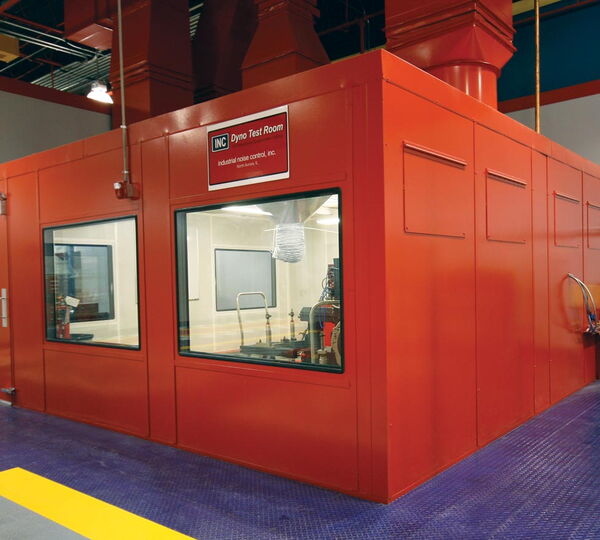Sound Testing, Containment, and Measurement
Acoustic test cells are isolated, sound-treated enclosures designed to house noise-generating equipment or conduct controlled acoustic testing. These rooms block external noise, contain internal sound, and allow for accurate sound level measurements without interference from environmental conditions. Test cells are often used in product development, quality control, noise compliance testing, and sound source identification.
These enclosures typically feature heavy-duty exterior wall systems constructed with high-STC barrier panels, steel frames, and resilient mounting. The interiors are lined with sound-absorbing treatments—such as perforated metal or fabric-faced panels—to control reflections and reverberation. Many test cells also include HVAC silencers, cable penetrations, observation windows, and ventilation to support ongoing testing operations.
Who Uses Acoustic Test Cells?
Acoustic test cells are used by a wide range of industries, including:
Automotive Manufacturers – for engine testing, drivetrain analysis, and vehicle cabin noise simulation
Aerospace and Defense – for component testing, jet engine noise analysis, and unmanned system development
Consumer Electronics – to test fans, speakers, appliances, and sound-emitting products
HVAC and Appliance Companies – for fan and compressor noise evaluation
Research Institutions and Universities – to conduct acoustic studies and product performance testing
Certification Labs – for third-party verification of noise levels and product compliance
Types of Acoustic Test Cells
Standard Enclosures These test cells feature high-mass, sound-blocking construction with integrated absorptive surfaces. They are ideal for isolating machinery or capturing accurate acoustic measurements in industrial or R&D settings.
Anechoic Chambers A type of test cell designed to simulate a free-field environment by absorbing nearly all reflections from walls, ceiling, and floor. Anechoic chambers are often used for microphone calibration, sound power level testing, or speaker performance analysis. They typically include wedge-shaped foam or fiberglass absorbers and are available in hemi-anechoic (floor-reflective) or fully anechoic designs.
Reverberation Rooms Unlike anechoic chambers, these test cells maximize reflections and are used to study how sound behaves in highly reverberant environments. These are essential for durability and transmission loss testing.
Hybrid Test Cells These are multi-function rooms that allow users to switch between anechoic and reflective conditions or simulate specific sound fields. They’re ideal for R&D environments requiring flexibility.
Key Features and Benefits
- High Noise Reduction: Up to 40–60+ dB of transmission loss
- Precision Absorption: Custom interior treatments tailored to frequency range and testing standards
- Structural Integrity: Modular or welded steel construction for long-term performance
- Custom Ventilation and Access: Includes silenced HVAC, cable ports, personnel doors, or removable panels for equipment access
- Data Accuracy: Minimized background noise for repeatable, reliable sound level measurements
- Flexible Footprints: Available as pre-engineered kits or fully custom installations

Frequently Asked Questions
A: Test cells should be used any time precise noise data is required or when a noise source must be contained to avoid affecting workers or neighboring spaces. They are essential for product development, quality assurance, and noise compliance testing. In facilities where noise levels must be closely monitored—such as laboratories, R&D departments, or certification centers—test cells provide the isolated environment necessary to obtain repeatable, accurate acoustic data. They are also important in preventing cross-contamination of sound between adjoining areas and maintaining employee safety and comfort.
A: Depending on construction, test cells can achieve 40 to 60+ decibels of transmission loss. The level depends on panel construction, door seals, penetrations, and installation quality. Advanced test cells that include floating floor systems, multi-layered composite panels, and acoustically treated access points can achieve even higher levels of isolation, making them suitable for the most demanding testing applications. This high level of sound reduction ensures compliance with ISO, ASTM, and other acoustical measurement standards.
A: They are typically built using modular acoustical panels, steel framing, vibration isolators, and absorptive interior treatments. Designs vary depending on performance goals and whether the test cell is free-standing, retrofitted, or part of a new build. The modular construction allows for faster installation and future reconfiguration or relocation if necessary. Interior finishes can include fabric-wrapped panels, perforated metal, or wedge-shaped foam, while access is provided through acoustically rated doors and observation windows. Each element is designed to work in harmony to ensure minimal transmission of airborne and structure-borne noise.
A: A test cell is designed to isolate noise and control internal reverberation, while an anechoic chamber goes further—creating an echo-free environment to simulate open-air acoustic conditions. Anechoic chambers use deep absorptive wedges on all surfaces to absorb over 99% of sound reflections, ideal for precise microphone and speaker testing. In contrast, standard test cells may include some reflective surfaces or lower absorption levels, depending on the test objectives. Each serves a different acoustic need: containment and isolation vs. free-field simulation.
A: Yes. Test cells can be customized for size, shape, ventilation, cable access, observation needs, lighting, and testing instrumentation. We also provide specialized penetrations, HVAC silencers, and access ports for dynamic equipment. Whether testing an engine, appliance, or piece of electronics, DDS can tailor the cell to your operational workflow, integrate real-time monitoring systems, and support unique performance requirements such as airflow, power access, and data cabling.
A: Yes. Test cells that house active equipment require silenced ventilation to maintain temperature and airflow without compromising acoustic isolation. We integrate HVAC silencers and low-velocity air systems into our designs. This ensures thermal comfort, safe equipment operation, and air quality inside the cell, while preserving the acoustic integrity necessary for accurate testing. Depending on the application, temperature and humidity controls can also be added.
A: While not required, acoustic test cells benefit greatly from acoustical consultation. DDS Acoustical Specialties partners with consultants or leads the design process to ensure your cell meets testing standards and acoustic targets. Our team can support acoustic modeling, regulatory compliance, and performance validation through each stage of the project. With the right collaboration, we help ensure your test environment performs with precision, reliability, and longevity.

